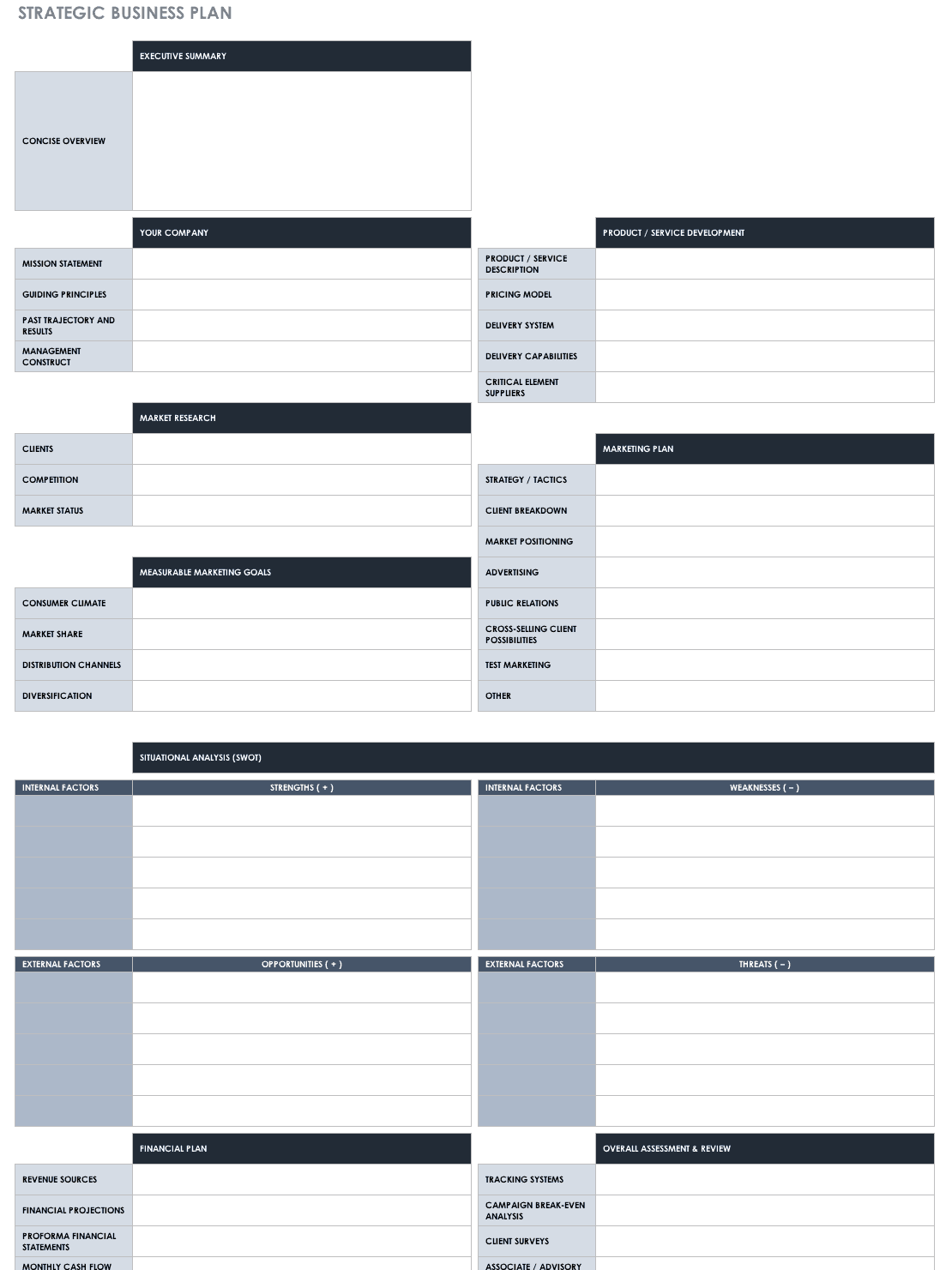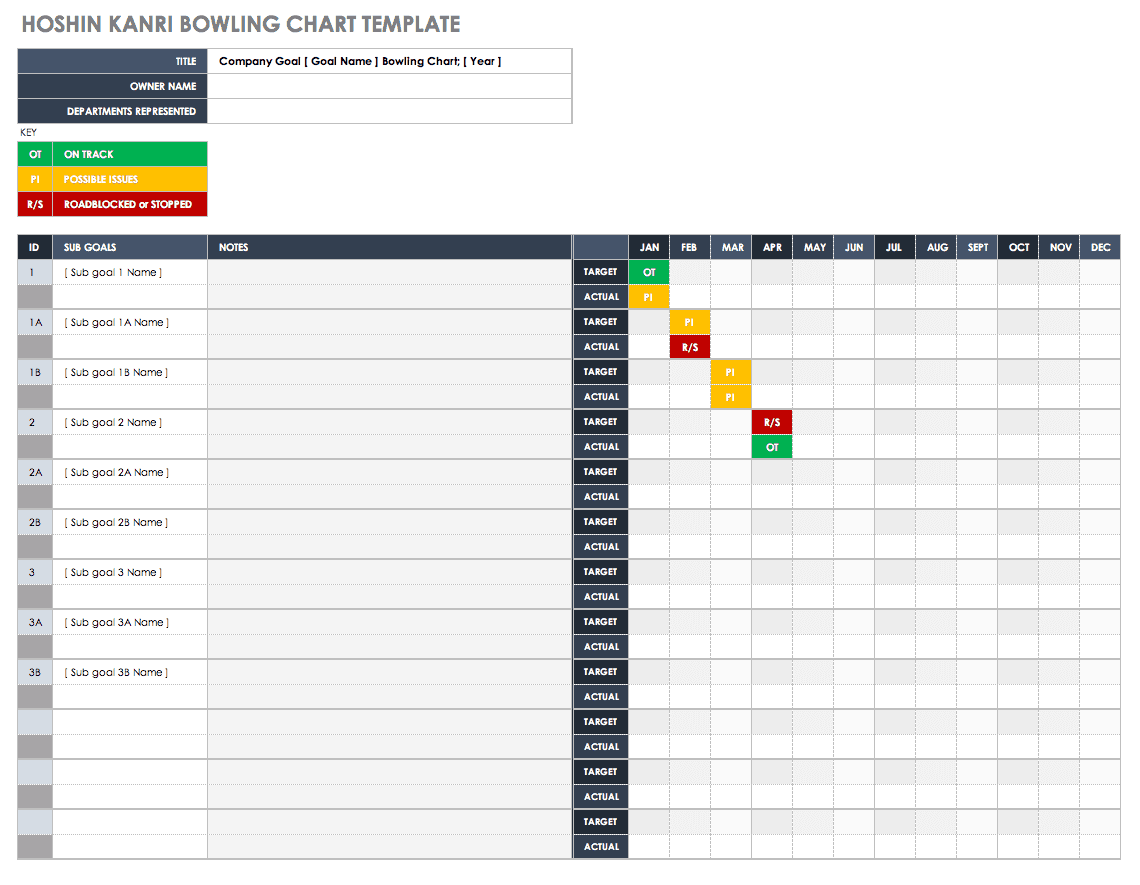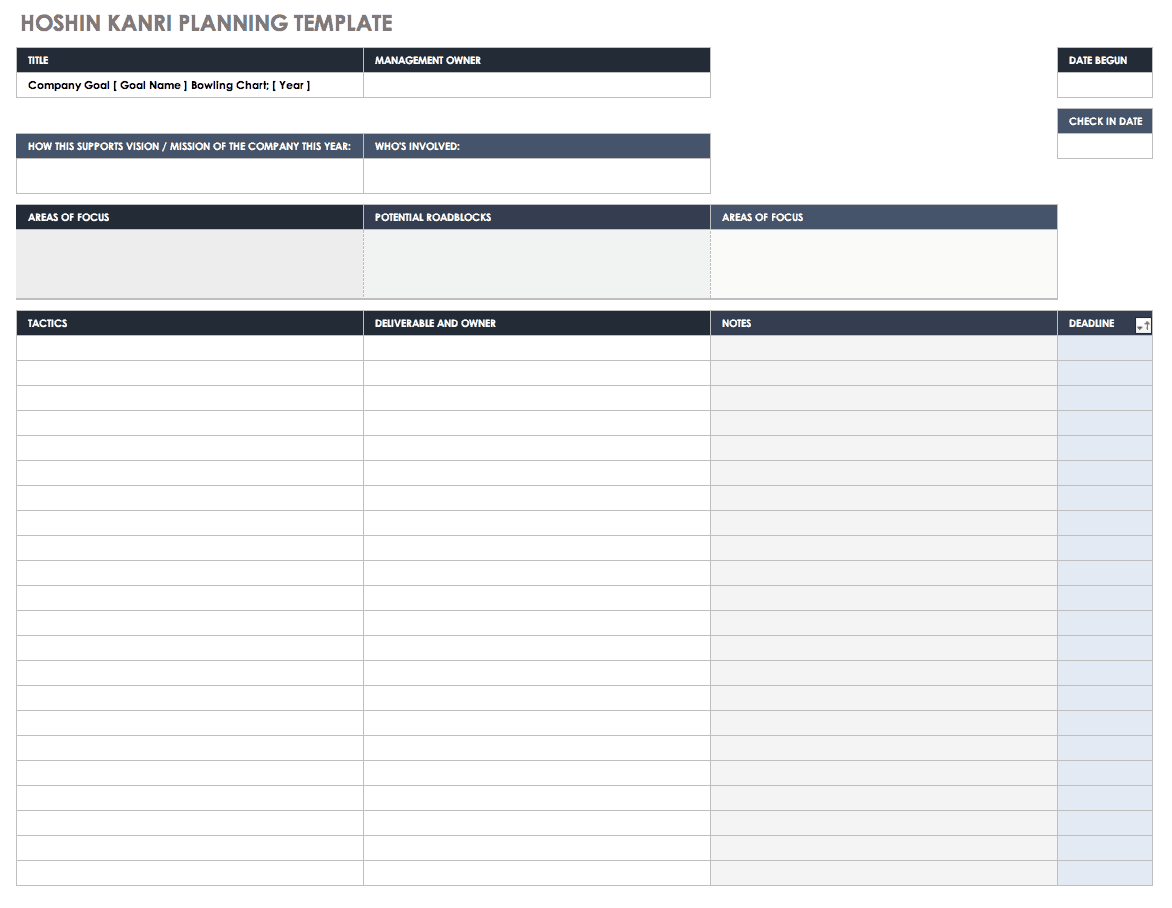What Is the Meaning of Hoshin?
Hoshin Kanri is a lean method of organizational operations that mandates buy-in from everyone in an organization for company goals. The idea is that company goals can’t be achieved if they are created at the top levels of an organization and simply pushed down onto lower departments. Instead, Hoshin Kanri prioritizes up-front conversations and goal-honing from the top to the middle to the bottom, and then back up.
For Hoshin Kanri to be effective, you need to align the following three organizational levels throughout the company:
- The Strategic Level: This includes the vision, mission, and annual goals of the company. Typically, these goals are created or articulated at the highest executive levels.
- The Mid-Level and the Tactical Levels: At the director or middle manager level, a company’s projects and initiatives are created and executed. The goals of the company need to be aligned closely at this level to ensure that every project upholds and drives forward each company goal.
- The Worker Level: This is the operational level where everyone in an organization is contributing in some way. The creation and execution of individual deliverables at this level should be aligned with the company goals as well. In addition, employees involved in Hoshin Kanri feel much more invested in a company’s goals’ success.
The idea is that every employee, at every level, must be working to align with the top-most goals set each year by the company. Employees get input, which needs to be incorporated into the goals, and as a result, employees feel ownership. This two-way flow of information is critical. The passage of input both up and down the hierarchical and management chain creates a feedback loop known as catchball, which is explained below.
What Is a Breakthrough Objective?
Hoshin Kanri is built around the idea of breakthrough objectives, also called stretch goals. These are internal goals that map to the Ansoff Matrix, which is a strategic planning tool to help organizations plan for growth. As shown in the graphic below, this method of mapping goals and objectives outlines four quadrants of growth. They are mapped to current customers and customers a company hopes to gain; and to current projects and initiatives and new (“stretch") initiatives.
Outlining these breakthrough goals is step two of the seven steps of Hoshin Kanri planning. Outlining these breakthrough goals — and getting employee buy-in on them throughout the organization — will help ensure that the energy of the entire company is pulling in the same strategic direction. This also helps ensure transparency to every employee, which in turn builds trust and buy-in at every level.
What Is the Catchball Process?
In the catchball process, top executives gain buy-in from the top management level on the company’s annual goals. Then, each executive gets the input of the director and middle-management level. This feedback is floated back up to the top executives, and the goals are refined and adjusted. The middle-managers then get their staff’s feedback and send it back up through middle management to the executive level, and so on.
As Hoshin expert William “Wes” Waldo has said, at its core, “[the catchball process] simply means ‘getting everyone involved.’”
The process is named as such because it’s like a game of catch. The C-level tosses the goals to middle management, which refines and gives input and tosses it back up to the top. Once refined, the goals are tossed back to middle management, who then tosses goals to the worker and operational level, where the goals are then further refined. From there, they are tossed back to middle management and back to the C-level.
Ideally, the goals aren’t finalized until every employee at every level has a say. These contributions can include refining — and even rejecting — some of the goals. Once everyone at the company has weighed in, the goals are publicized and socialized — as the employees themselves have already bought into the goals. In this way, goals become something more than an annual directive issued from top management. Instead, they become ever-evolving objectives that everyone is invested in, and that can be revisited quarterly or monthly and then refined as the next new year approaches.
At first blush, this may not sound like a lean tactic at all. Getting every single employee involved in the goal-setting process can definitely take some time. But many organizations have found that front loading the strategy and goal-setting process can streamline how work is done and progress is measured throughout the year. And more importantly, if everyone in the company is aligned with the goals from the beginning, everyone feels ownership in achieving those goals.
What Is a Strategy Deployment?
Strategy deployment is another loose translation for Hoshin Kanri. It is specifically meant to define those types of organizational goal-setting that rely on the input of everyone involved in achieving goals or solving challenges. Because this kind of plan gets input and feedback from everyone up and down the organizational chain, deploying the plan is more efficient and easier because everyone affected has already committed to its principles.
Some corporations use the term strategy deployment in a variety of ways that do not align to Hoshin Kanri, or even to lean or Six Sigma principles, so there can be confusion. These companies may adhere to the top-down method of goal setting, in which top executives decide the goals and direction for a company for the coming year, and refer to anything employees do to fulfill these goals as strategy deployment. In these scenarios, the opportunities for success are more limited, because employees who have goals thrust upon them — instead of feeling ownership in having helped create them — are less likely to feel as invested in achieving these goals.
However your organization deploys strategy planning, especially in a lean environment, it can be extremely helpful to the organization and its growth, stability, and success. Check out these strategic planning templates to get your goals front and center.
You can use this general, flexible template for Excel to get started. Capture all the relevant information about your company, goals, opportunities, risks, and much more with this strategic business plan template.
Download Strategic Business Plan Template
The History of the Hoshin Method: First Japan, Then the World
Since the 1950s, Toyota and other companies in Japan have made successful use of Hoshin Kanri planning. Major corporations in the U.S. and elsewhere caught on in the 60s and 70s. Because of their focus on achieving vital stretch goals and their insistence on eliminating silos and waste in any process, Hoshin and other Lean methods have continued to gain popularity all over the world. In recent years, Bank of America has been public about its embrace of Hoshin planning and Lean Six Sigma principles.
Hewlett-Packard first used the Hoshin directional planning process in 1976 at YHP, the company’s Japan-based subsidiary. The Japanese words “hoshin kanri” generally translate to “direction (setting) management for the entity.” The words “nichijo kanri” generally translate to “daily (fundamental) management for the entity.” The fusing of these two methods is key to the success of the Hoshin process.
As American companies began to study the efficient, streamlined production processes of successful Japanese manufacturers, they started adopting Hoshin Kanri and many other lean techniques that focus on breaking down silos and getting alignment and buy-in from every employee.
How Does Hoshin Make a Company’s Strategic Plan Work?
Asue says that the core process supporting any Six Sigma culture, including Hoshin Kanri, is DMAIC (define, measure, analyze, improve, control): “The acronyms can vary, but the process boils down to three critical activities.” These include the following:
- Using data to define the problem.
- Removing the process waste that’s getting in the way of hitting goals.
- Remembering to iterate, iterate, iterate
The reason Hoshin Kanri succeeds, Asue emphasizes, is that, “Everyone in a company follows the Hoshin Kanri process to solve problems, from the forklift driver to the CFO.”
Hoshin Kanri typically follows the following principles:
- Limit the number of company goals to a maximum of five per year (the fewer, the better).
- Outline clear steps to achieve goals and continually revisit them.
- Seek feedback from every level of the organization and incorporate it into your overall plans.
- Make sure that every employee buys into goals and feels a sense of ownership.
- Use the catchball process to ensure that your employees are tossing the “ball” (i.e., concept/big idea), all around the company — from the top to the middle to the bottom to the middle to the top — in a continuous feedback loop. By doing this, you improve the plan and refine your goals over time, rather than simply announcing goals from the top. This method allows the whole company to participate in achieving long-term goals.
“The executives recognize that they don’t do the everyday work. So, they want feedback from the people closest to the customer in order to understand how their targets and tactics might be wrong,” Asue points out.
What Are the Seven Steps of Hoshin?
Hoshin involves seven key steps, all of which contribute to an organization’s overall strategic planning.
-
Identify the KPIs and the vision for the direction of the company. “This is your ‘why,’” Asue says. “The vision should inspire change, not be a directive that comes from the top.”
-
Outline the breakthrough objectives (that is, the goals). There should be no more than five (and typically three to four) for existing and new customers. These objectives, also called stretch goals, lead to growth throughout the organization.
-
Set the schedule for achieving these goals. Asue says it’s helpful to think ahead: “Where do we need to be in one year if we want to be at X in five to seven years?”
-
Begin and continue the catchball process, all the way from the top to the bottom and back up again, in order to socialize and get input, refinement, and buy-in from the entire organization.
-
Set up review cycles to evaluate the efficacy of your tactics among the people closest to your customers. These cycles can be weekly, monthly, quarterly, etc. To track how you’re progressing month by month, consider using a bowling chart. Try this Hoshin Kanri bowling chart template to keep track of how various efforts and programs are progressing, which months might be ahead, which may be slower, etc.
Download Hoshin Kanri Bowling Chart Template – Excel
-
Take action when the review shows that the organization, team, or project has missed a goal or KPI, and take steps to get back on course.
-
Engage in an in-depth, annual review of objectives to determine the adjustments you need to make for the coming year. Getting input from everyone in the organization is crucial to the company’s growth and improvement.
If you want to try implementing Hoshin Kanri in your organization, use this template to capture high-level information, such as team leaders and project goals. The template also allows you to drill down into specific tasks, task owners, delivery timelines, and the health of deliverables.
Download Hoshin Kanri Planning Template - Excel
How Does Hoshin Work in Small, Medium, and Enterprise-Level Companies?
Hoshin is most often thought about in terms of enterprise-level companies. That’s because the process was conceived by a large company, Toyota, to address issues that are intrinsic to large organizations. In a large enterprise, the risks of non-alignment with goals are many: enormous waste, silos, resentment on the part of employees who don't feel involved or valued, and frustration on the part of staff who don’t have a clear understanding of their roles.
Hoshin helps achieve and maintain buy-in and enthusiasm for goals and growth throughout the enterprise, no matter how big. In addition to Toyota, here are some other enterprise and global companies that have seen success using Hoshin:
- Bank of America
- Danaher
- Scania
- Boeing
- Hewlett-Packard in Japan
Jean Cunningham is a leader and expert in instituting Hoshin Kanri in medium-sized companies. Cunningham formerly worked at Lantech, a stretch-packaging company in Kentucky, and she has spoken nationally about how she implemented Hoshin there. She has said that each employee knew clearly they needed to contribute in three ways:
- Doing their own job as well as possible
- Using relevant lean thinking and feedback to help align their job and department to the company goals
- Embracing long-term breakthrough goals to help the company grow
“The Kaizen results affected every process and employee in the company and were wonderfully successful for both the employees and the company's bottom line,” Cunningham wrote. Reducing waste throughout departments eventually became the norm, which enhanced the company’s growth and employees’ satisfaction.
For small companies or startups, using a front-loaded process like Hoshin can be a little more complicated. Some startups dismiss Hoshin as too bureaucratic, despite being pitched as nimble and scrappy. And that can be true, but for the long-term success of a company, you still need buy-in from employees and to let them how their work supports the goals of the company. Often in small companies, everyone needs to do and own everything at the beginning, but that mentality isn't sustainable.
Also, if you’re going to ask startup work hours from even the most dedicated employee, it’s a good idea to let them know what’s in it for them. Taking the time to seek employee input, and taking that input seriously, is key to startup and small company success. If you can’t accommodate the full documentation of all the goals and processes, at least embrace the feedback loop.
Asue says, “I was part of a Fortune 300 company implementing the Lean Six Sigma, and Hoshin Kanri was a core part of our implementation plan. In my role now as a consultant, I’ve used the same process I built for our Fortune 300 company at companies less than three years old or doing less than $5 million in revenue.” She’s had strong results in all cases..
Regardless of the size of the organization, efforts at refinement can fade if the commitment is weak and the milestones aren’t public. To succeed, you need to own your goals — and your plan — and keep them front and center.
How Does Hoshin Compare to Other Strategic Disciplines?
As far as business philosophies are concerned, there are dozens of strategic styles, schools of thought, and disciplines, all with their benefits and passionate adherents. Here are some of the more popular ones and how they compare to Hoshin:
- Kaizen: Kaizen is the overarching Japanese philosophy of constant improvement. Hoshin is one aspect of Kaizen that focuses on a company’s goals, progress, and overall direction.
- Agile: Agile sprints can align in a Hoshin environment as long as all the projects and efforts contained in each sprint have first been aligned and supported across the company.
- Waterfall: Waterfall is a traditional top-down mode of management and company culture. Hoshin is a Waterfall-style model with one critical difference: The water flows up as well as down.
- Six Sigma: In the mid-1980s, Motorola coined the term Six Sigma and created the idea of levels of expertise reflected in “belts.” The main theme of Six Sigma is the reduction of waste and friction. The method first applied specifically to manufacturing, but quickly grew in popularity, making itself relevant to every type of organization and corporation. Hoshin represents the goal-setting and goal-achieving element of Six Sigma that helps the method reduce waste and churn.
- Kanban: Kanban boards are tools that help managers and workers visualize the components of a project. The boards can be organized in many ways to illustrate progress, such as having columns that say “requested,” “in process,” “roadblocked,” and “completed.” Hoshin Kanri goals can be represented visually using Kanban boards, and individual goals and sub-goals can be mapped under the annual goals to indicate progress.
How to Implement Hoshin at Your Company
In its simplest form, Hoshin Kanri simply means outlining goals and continuing to seek and implement feedback from every level of your organization in a continuous loop. So, in theory, any company with committed employees can attempt to implement Hoshin Kanri and succeed. But, having a consultant on board can help the process considerably. This expert can provide indispensable guidance regarding the nature of tasks and why they’re important. Empowering employees at the “forklift” level will likely have far greater appeal across the company than imposing goal processes from the top down.
The differentiator for Hoshin, as mentioned above, is that it holds that breakthrough goals need to be captured, shared, and approved by everyone in the company. After you’ve completed that step, list the individual, departmental, and sub-goals that align with those larger goals. You can then revisit those objectives monthly, quarterly, and annually. And, if things go well during that first year (as a result of strong commitments and continual refinement), you’ll probably have no need to (in the words of Wes Waldo) “invent a new goal for the next year.” Instead, the next year’s goal will be a refinement and stretch of the previous year’s goal — one against which the company has already been performing and measured.
In order to successfully implement Hoshin Kanri at your company, you need to follow the seven steps, ensure that the catchball process is transparent and regular, and make sure that everyone embraces the breakthrough goals. After that, it’s all about refining and improving.
Implement Hoshin Kanri Processes with Real-Time Work Management in Smartsheet
Empower your people to go above and beyond with a flexible platform designed to match the needs of your team — and adapt as those needs change.
The Smartsheet platform makes it easy to plan, capture, manage, and report on work from anywhere, helping your team be more effective and get more done. Report on key metrics and get real-time visibility into work as it happens with roll-up reports, dashboards, and automated workflows built to keep your team connected and informed.
When teams have clarity into the work getting done, there’s no telling how much more they can accomplish in the same amount of time. Try Smartsheet for free, today.



